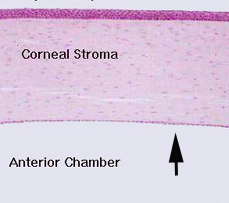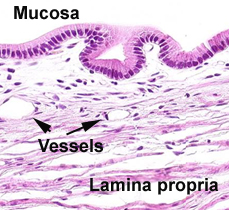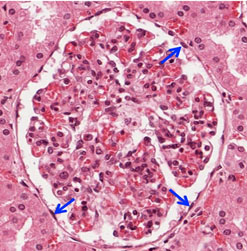
Let’s start with simple epithelia. A
simple epithelium is one cell layer thick, and the cells may be
squamous, cuboidal, or columnar in shape. Depending on its location,
this type of epithelium can function to line and protect an organ or
participate in absorption and secretion. First, let's look at
simple squamous epithelium.
- First examine the cornea of the
eye
 , where simple squamous epithelia can be found as the inner
lining of the cornea (arrow). Squamous epithelial cells are very
thin and flat. , where simple squamous epithelia can be found as the inner
lining of the cornea (arrow). Squamous epithelial cells are very
thin and flat.
 The epithelium lining the lumen
of blood vessels (endothelium) is also a good example of simple
squamous epithelium. To the right is
an image of a gallbladder with small vessels in the lamina
propria (Lamina what?). See if you can locate some blood vessels
with their lining of simple squamous epithelium in the
connective tissue of the gallbladder. The epithelium lining the lumen
of blood vessels (endothelium) is also a good example of simple
squamous epithelium. To the right is
an image of a gallbladder with small vessels in the lamina
propria (Lamina what?). See if you can locate some blood vessels
with their lining of simple squamous epithelium in the
connective tissue of the gallbladder.
-
 Another place where simple
squamous epithelium (arrows) can be found is in the capsule of
the renal corpuscles of the kidney where blood is filtered to
produce urine. Locate some renal corpuscles with their capsule
of
simple squamous epithelium in this example. Another place where simple
squamous epithelium (arrows) can be found is in the capsule of
the renal corpuscles of the kidney where blood is filtered to
produce urine. Locate some renal corpuscles with their capsule
of
simple squamous epithelium in this example.

Now for simple
cuboidal epithelium. |